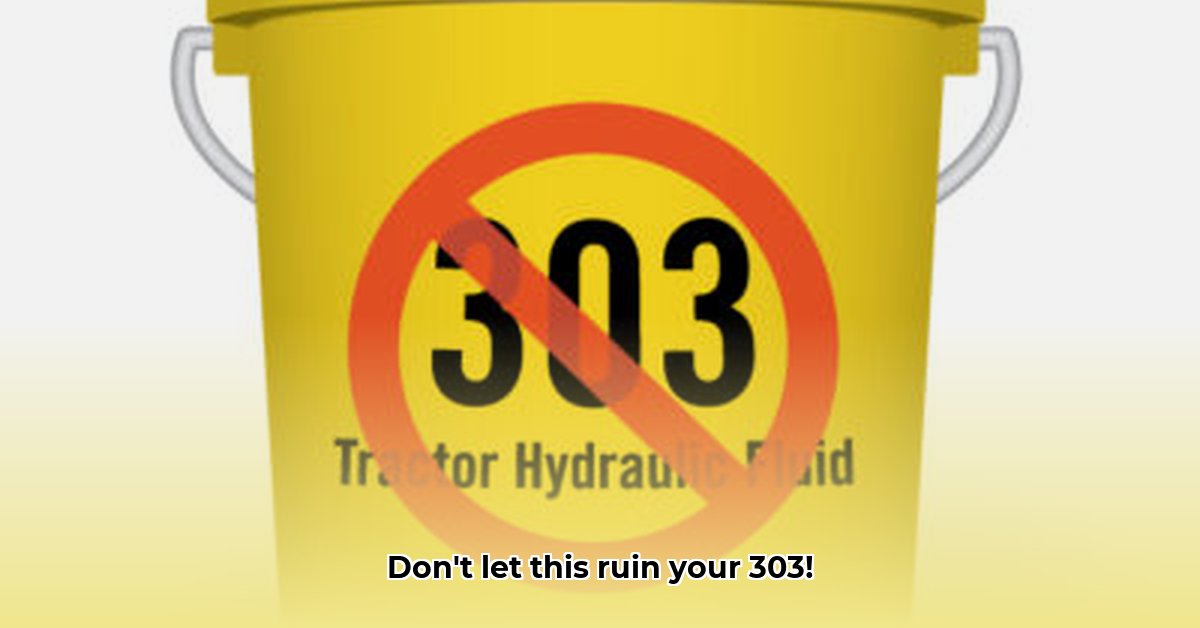
303 Tractor Hydraulic Fluid: Understanding the Risks and Benefits of Modernization
The term "303 tractor fluid" often sparks discussion among farmers, sometimes laced with uncertainty. This article clarifies the complexities surrounding this older hydraulic fluid type, explaining why using outdated or mislabeled "303" fluids can pose significant risks and highlighting the advantages of transitioning to modern, OEM-specified hydraulic fluids. We'll explore the potential problems, offer practical advice, and emphasize the long-term cost savings and equipment longevity associated with making the switch. For more information on tractor fluids, check out this helpful resource on tractor engine oils.
The Legacy of "303": Why Sticking With It Is Risky
The original 303 formulation, now obsolete, contained ingredients no longer used due to environmental and ethical concerns. Many fluids currently labeled "303" vary significantly in quality and composition. This inconsistency poses a substantial risk. Using an inferior substitute is akin to using incorrect engine oil in your car — the consequences can be severe.
Using inferior "303" fluids can lead to problems such as:
- Reduced Hydraulic Power: The hydraulic system may operate sluggishly, decreasing efficiency and productivity, potentially resulting in noticeable delays when using the controls. This directly impacts work speed and profitability. Has your tractor's response time become noticeably slower?
- Accelerated Wear and Tear: Improper lubrication leads to increased friction and component wear, potentially necessitating more frequent and costly repairs. Are you experiencing more frequent hydraulic system malfunctions than expected?
- Increased Repair Costs: The resulting breakdowns translate directly into expensive repairs and frustrating downtime, severely impacting your operational budget. What is the impact of downtime on your profitability?
- Warranty Voiding: Using an unapproved fluid often voids manufacturer warranties, leaving you financially responsible for any subsequent repairs. Did you know using the incorrect fluid can void your machinery warranty?
The Advantages of Modern OEM Hydraulic Fluids
Modern OEM (Original Equipment Manufacturer)-specified hydraulic fluids offer significant advantages over older formulations:
- Enhanced Protection: Advanced additives protect against wear, corrosion, and oxidation, extending component life and reducing maintenance needs. Have you considered the long-term benefits of superior protection against corrosion?
- Improved Efficiency: These fluids offer superior flow characteristics, leading to smoother hydraulic operation and enhanced efficiency, maximizing productivity and fuel economy. How much would a 5% gain in hydraulic efficiency impact your annual output?
- Extended Lifespan: Reduced wear and tear translate into a longer service life for your tractor's hydraulic components, reducing replacement costs over the long term. What's the return on investment of extending your tractor's lifespan by 15%?
- Warranty Compliance: Using OEM-recommended fluids maintains warranty coverage, protecting your investment and providing peace of mind. Is your tractor's warranty still valid?
A Step-by-Step Guide to Upgrading Your Hydraulic Fluid
Switching to the correct fluid is a straightforward process:
- Consult Your Owner's Manual: This document specifies the exact fluid type and quantity required for your tractor model. Never disregard the manufacturer's recommendations.
- Verify Fluid Specifications: Obtain the data sheet for the potential replacement fluid. Ensure it matches your tractor's requirements regarding viscosity, pour point, and other critical properties. Confirm the fluid matches the recommended viscosity grade for your climate.
- Choose Reputable Suppliers: Purchase OEM-approved fluids from authorized dealers to guarantee authenticity and quality. Are you confident in the source of your current hydraulic fluid?
- Careful Label Reading: Check for precise specifications and certifications; avoid vague labels like "303."
Collaborative Responsibility: A Shared Approach to Improvement
Successfully transitioning away from unreliable "303" fluids requires a cooperative effort:
| Stakeholder | Key Actions |
|---|---|
| Farmers/Owners | Transition to OEM-specified fluids, rigorously check labels, verify specifications using data sheets, and source fluids from reputable suppliers. |
| Equipment Manufacturers | Clearly state fluid specifications and produce educational materials for farmers. |
| Regulatory Bodies | Enhance labeling standards and enforce regulations to prevent misleading marketing practices. |
| Fluid Manufacturers | Provide complete and transparent product information, ensuring fluids meet OEM specifications. |
The Long-Term Perspective: A Sound Financial Investment
Though premium OEM fluids may have a higher initial cost, the long-term savings significantly outweigh the expense. Preventing costly breakdowns, minimizing downtime, and maintaining warranty coverage translate into considerable financial advantages. Choosing the right hydraulic fluid isn't merely an expense; it's a strategic investment in your equipment and farm's future profitability. Don't let outdated practices compromise your operation’s success – upgrade your hydraulic fluid now.
Three Pivotal Points:
- Using obsolete or mislabeled "303" hydraulic fluid risks significant damage and repair costs.
- Modern OEM-specified hydraulic fluids offer superior protection, efficiency, and extended equipment lifespan.
- A collaborative effort between farmers, manufacturers, and regulators is crucial for promoting the use of appropriate fluids.